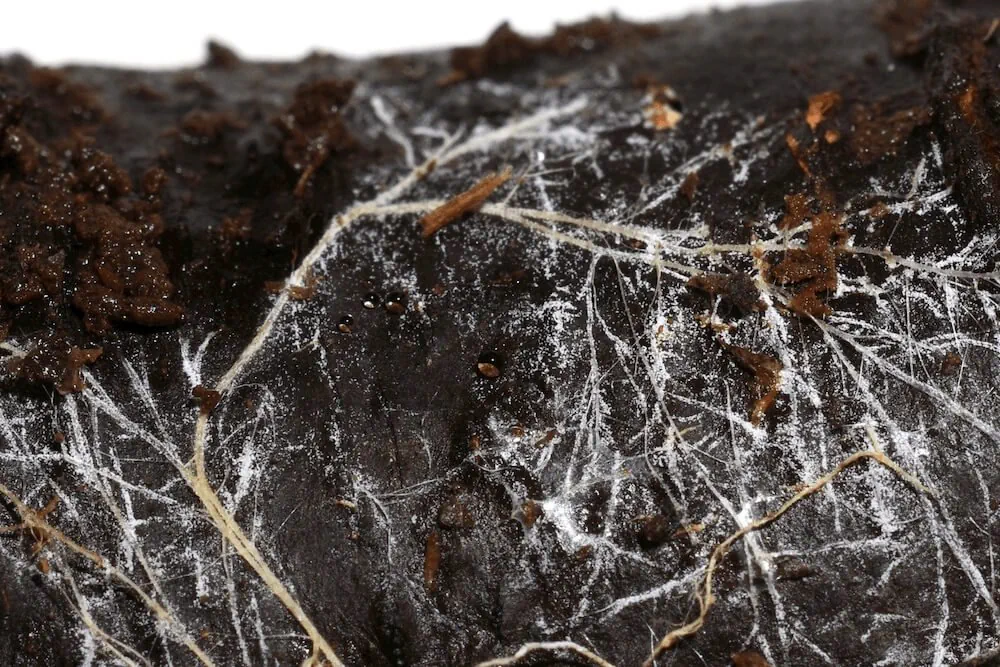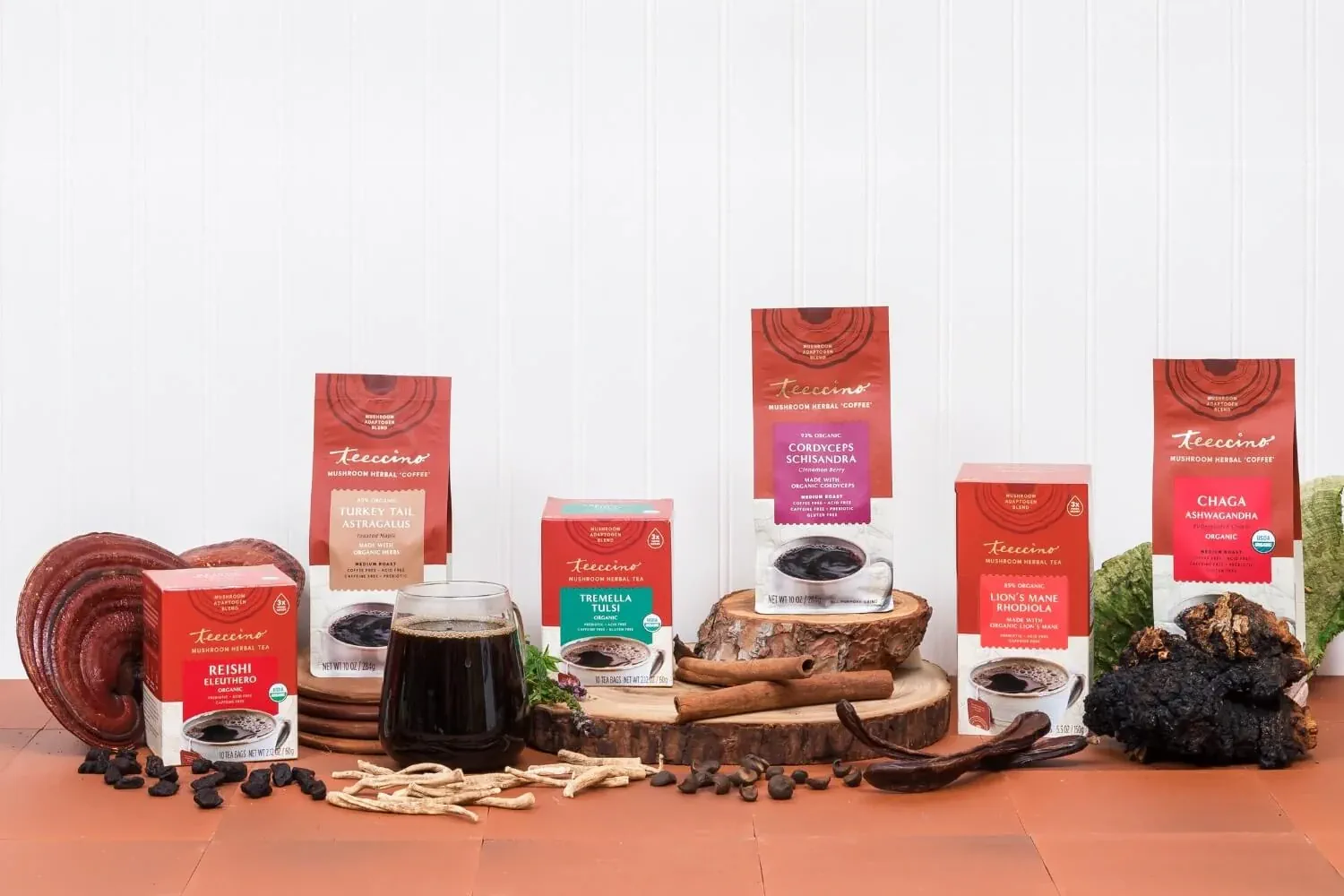Of the six wellness mushrooms in Teeccino Mushroom Adaptogen Coffee & Tea blends, guess how many are associated with increased longevity and immunity? All six! When you delve into both their historic reputations and any scientific studies about them, you find this recurring theme: wellness mushrooms increase immunity and thus lead to longevity.
Now, science has identified the antioxidant and anti-inflammatory compound in mushrooms that turns out to be essential for good health and strong immune systems. It’s called Ergothioneine, or ERGO for short.
Sadly, most Americans don’t eat many mushrooms, and of course it’s the more exotic mushrooms associated with wellness that have the most ERGO, rather than the common button mushrooms that we see in the grocery store.
I’m super excited about the discovery of ERGO’s amazing health benefits, so I’m devoting this Month’s Healthy Tips Newsletter to mushrooms. Plus coming up on October 15th is National Mushroom Day, so what better time to learn how to put more mushrooms in your diet?
ERGO's importance to health
ERGO is being compared to glutathione, the major antioxidant that humans produce in their livers. Glutathione combats oxidative stress throughout our bodies and protects us from developing chronic diseases associated with aging like Alzheimer’s, Parkinson’s and heart disease.
One big difference though: ERGO isn’t produced in our bodies. We have to eat it in order to get any. Recently, a German biochemist discovered that our bodies have a special transporter just for ERGO that is super-efficient at rapidly distributing it via our blood to tissue cells throughout our bodies. Those tissues that are under the most stress get the most ERGO.
A recent study of 3,200 people consuming a healthy diet in Sweden revealed that out of 112 metabolites in the human diet, ERGO was the one with the strongest association to the prevention of cardiovascular disease and decreased mortality. Let’s all eat more mushrooms and drink mushroom coffees and teas!
An analysis of different cultures’ consumption of ERGO showed the same correlation for lower cardiovascular disease and death from degenerative diseases with higher amounts of ERGO. Of course, the Italians beat Americans with over 4 times the amount of ERGO in their diets – maybe their longevity and good health isn’t just due to how much olive oil they consume!
Is ERGO the next super vitamin?
ERGO is generating so much attention and excitement about its potential to reduce chronic diseases associated with aging that a renowned antioxidant research scientist, Dr. Bruce Ames, has said that ERGO should be considered a longevity vitamin in our diets – move over Vitamin C!

Regenerative agriculture, fungi and ERGO
Here’s even more exciting news about ERGO: You can get ERGO from other foods too since it is widely distributed across the food chain albeit in small quantities. However, one thing needs to be present – fungi in the soil your food is grown on. Soils rich in fungi are soils which haven’t been disturbed by tilling, which means our industrialized agricultural practices need to be reformed by reducing plowing in favor of non-tilling methods to improve soil health.
Building healthier soil is the thrust behind the regenerative agricultural movement, and now there is an actual measurement that identifies a positive connection between soil health and human health. A study proved that corn, soybeans and oats all contained on average 30% more ERGO when the fields they were grown in hadn’t been plowed.
Mycelium and soil health
So now we know one thing for sure: soil health - which is intertwined with plant and human health - is dependent on intact fungal networks. The part of the fungi growing underground, called the mycelium, is a network of thread-like cells, one single cell deep, that are tangled up so thickly that over 8 miles of mycelium live within a single cubic inch of soil! They move carbon, nutrients and moisture underground to nourish the plant community above ground while also digesting dead plant mass back to become soil.
The largest living thing on our planet is a mass of mycelium in Oregon that covers 3.5 square miles and – get this – has been alive for 10,000 years!

Mushrooms compared to trees
Mycelium can be thought of as the roots, trunk and branches of a tree. What we think of as mushrooms are actually the “fruiting body” of the mycelium which can be compared to the fruit of a tree. The fruiting body produces reproductive spores which compare to the seeds that fruits produce for reproduction.
Most science to date has been about the health benefits of fruiting bodies of mushrooms since that is what has been eaten historically. Until recently, no one thought much about mycelium since it is hidden underground. However, increasingly more studies are examining the health benefits and nutritional profiles of mycelium.
Mycelium versus fruiting bodies
Paul Stamets, one of the foremost mycologists (scientist who studies mushrooms) of our times, has pioneered the use of mycelium as a nutritional supplement. However there has been controversy about it. Some people believe that because mycelium is inexpensive to grow compared to fruiting bodies, American companies have competed with Asian growers of fruiting bodies by focusing on mycelium cultivation instead.
When I was creating Teeccino Mushroom Adaptogen blends, I delved into the science behind the health benefits of consuming mycelium. What I found was a growing body of research showing that mycelium particularly had a positive effect on the immune system. As Stamets points out, mycelium itself must have a strong immune system in order to live for thousands of years!
One criticism bothered me about mycelium though. Due to mycelium being grown on various substrates like rice and oats, high amounts of carbohydrates are still present in the mycelium and thus dilute its potency. Fruiting bodies don’t have any carbohydrates from the substrates they’re grown on since only the fruiting body itself is harvested. So much more research and historical information on the benefits of fruiting bodies exists compared to mycelium.
You may know that sourcing the highest possible grade of any ingredient I put in Teeccino is my absolute gold standard. I searched for an answer to this dilemma and fortunately discovered that one producer was growing mycelium on sorghum with the result of 95% of the carbohydrates being converted by the mycelium.

Teeccino Mushroom Adaptogen blends contain fruiting bodies and mycelium
With new science pointing to the benefits of mycelium and a quality that met my standards, I decided to put both the mycelium and fruiting bodies of reishi, turkey tail, lion’s mane and tremella mushrooms into Teeccino’s new blends. Using a 50-50 blend, we feel that we bring all the best elements of the whole ‘mushroom’ to our Teeccino blends. By the way, mycelium isn’t any less expensive than fruiting bodies!
Two exceptions where we don’t blend mycelium and fruiting bodies together are chaga and corydceps. Chaga, which is actually a “conk”, is comprised of mycelium intertwined with dead bits of the birch tree on which it grows. The fruiting body is actually beneath the birch bark, so what has been traditionally consumed as chaga is actually already mycelium.
Cordyceps is a fungi that overtakes a caterpillar’s chrysalis in the wild. It has become very rare due to over-harvesting. Now a different cordyceps species is cultivated on a grain substrate that fortunately has higher amounts of cordycepin, the key health promoting compound in cordyceps. Due to the Chinese-developed cultivation technique, commercially cultivated cordyceps already has both mycelium and fruiting body in it.
ERGO content in mushrooms
One last thought before I give you a list of the mushrooms that contain the most ERGO: there isn’t much science yet looking at the quantity of ERGO in mycelium but I was thrilled to read that there is a high ERGO mycelium being studied as a substrate for cultivating fruiting bodies. Hopefully it will become commercially available soon.
I’m convinced that the more ERGO we can pack into the food we eat, the longer we’ll live without age-related diseases. That includes cancer too because science shows that ERGO helps to protect our cells’ DNA. Studies have found that high amounts of mushroom consumption correlate with lower risk of cancer, particularly breast cancer.
One more cultural observation: Japan has a high rate of mushroom consumption and although it wasn’t included in the original study where the Italians came out on top, it is surmised that since the Japanese culture has the highest rate of longevity in the world (along with Hong Kong), it is very likely due to both cultures’ high consumption of wellness mushrooms.
Here’s the data on edible mushrooms:
#1: Porcini mushrooms = 7mg/ gram of dry weight(g.d.w.)
#2: Yellow oyster mushrooms = 4mg /g.d.w.
#3: Grey oyster mushrooms = 1.5mg /g.d.w.
#4: Maitaki mushrooms = 1+mg/g.d.w.
#5: Shiitake mushrooms = 1mg/g.d.w.
#6: Brown & white button mushrooms = -0.5mg/g.d.w.
We don’t have any results yet for our wellness mushrooms. Sorry, they haven’t been analyzed thus far but I’ll keep you posted as soon as we confirm the content of ERGO is found in them.
My recommendation is to visit your local specialty food store or Farmer’s Market where you’ll likely find beautiful fresh oyster mushrooms along with other wellness mushrooms for sale. Add them to your sauteed vegetable and rice dishes. Recently I ordered a vegetarian taco with oyster mushrooms in a hot Chile sauce that was spectacular. Mushrooms are the meat of a vegetarian diet. I intend to buy more oyster mushrooms and I’m on the hunt for porcinis too.
 In the meantime, today I’m enjoying a cup of Teeccino Mushroom Adaptogen Turkey Tail Astragalus because I’m in the mood for its toasted maple flavor. I alternate which of our Mushroom blends I drink to get all of them regularly. With 500mg of mushroom extract in each serving of our all-purpose grind and 300 mg per tea bag, you can drink a significant amount of mushrooms every day even if you don’t love eating them.
In the meantime, today I’m enjoying a cup of Teeccino Mushroom Adaptogen Turkey Tail Astragalus because I’m in the mood for its toasted maple flavor. I alternate which of our Mushroom blends I drink to get all of them regularly. With 500mg of mushroom extract in each serving of our all-purpose grind and 300 mg per tea bag, you can drink a significant amount of mushrooms every day even if you don’t love eating them.
Hope you are inspired to find more ways to include mushrooms in your diet too!


